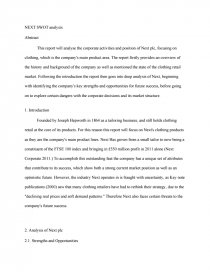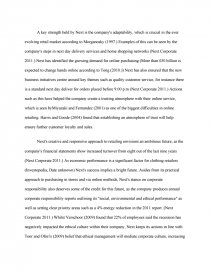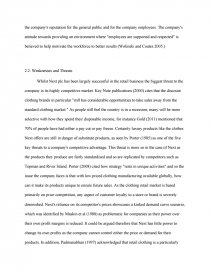The Corporate Activities
Essay by summertime09 • March 3, 2013 • Essay • 1,111 Words (5 Pages) • 1,002 Views
NEXT SWOT analysis
Abstract
This report will analyse the corporate activities and position of Next plc, focusing on clothing, which is the company's main product area. The report firstly provides an overview of the history and background of the company as well as mentioned the state of the clothing retail market. Following the introduction the report then goes into deep analysis of Next, beginning with identifying the company's key strengths and opportunities for future success, before going on to explore certain dangers with the corporate decisions and its market structure.
1. Introduction
Founded by Joseph Hepworth in 1864 as a tailoring business, and still holds clothing retail at the core of its products. For this reason this report will focus on Next's clothing products as they are the company's main product lines. Next Has grown from a small tailor to now being a constituent of the FTSE 100 index and bringing in £550 million profit in 2011 alone (Next Corporate 2011.) To accomplish this outstanding feat the company has a unique set of attributes that contribute to its success, which show both a strong current market position as well as an optimistic future. However, the industry Next operates in is fraught with uncertainty, as Key note publications (2000) saw that many clothing retailers have had to rethink their strategy, due to the "declining real prices and soft demand patterns." Therefore Next also faces certain threats to the company's future success.
2. Analysis of Next plc
2.1. Strengths and Opportunities
A key strength held by Next is the company's adaptability, which is crucial in the ever evolving retail market according to Morganosky (1997.) Examples of this can be seen by the company's steps in next day delivery services and home shopping networks (Next Corporate 2011.) Next has identified the growing demand for online purchasing (More than £50 billion is expected to change hands online according to Tong (2010.)) Next has also ensured that the new business initiatives centre around key themes such as quality customer service, for instance there is a standard next day deliver for orders placed before 9:00 p.m (Next Corporate 2011.) Actions such as this have helped the company create a trusting atmosphere with their online service, which is seen byMiyazaki and Fernandez (2001) as one of the biggest difficulties in online retailing. Harris and Goode (2004) found that establishing an atmosphere of trust will help ensure further customer loyalty and sales.
Next's creative and responsive approach to retailing envisions an ambitious future, as the company's financial statements show increased turnover from eight out of the last nine years (Next Corporate 2011.) As economic performance is a significant factor for clothing retailers (Investopedia, Date unknown) Next's success implies a bright future. Asides from its practical approach to purchasing in stores and via online methods, Next's stance on corporate responsibility also deserves some of the credit for this future, as the company produces annual corporate responsibility reports outlining its "social, environmental and ethical performance" as well as setting clear priority areas such as a 4% energy reduction in the 2011 report. (Next Corporate 2011.) Whilst Verschoor (2009) found that 22% of employees said the recession has negatively impacted the ethical culture within their company, Next keeps its actions in line with Toor and Ofori's (2009) belief that ethical management will mediate corporate culture, increasing the company's reputation for the general public and for the company employees. The company's attitude towards providing an environment where "employees are supported and respected" is believed to help motivate the workforce to better results (Wolinski and Coates 2005.)
2.2. Weaknesses and Threats
Whilst Next plc has been largely successful in the retail business the biggest threat to the company is its highly competitive market. Key Note publications (2000) cites that the discount
...
...



